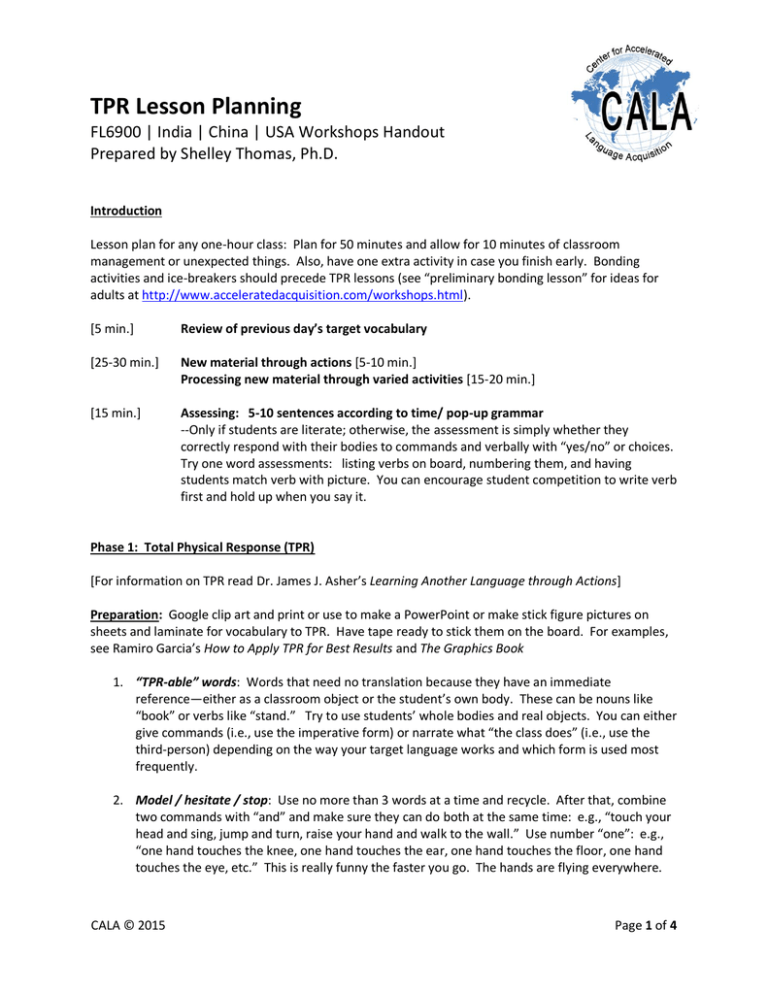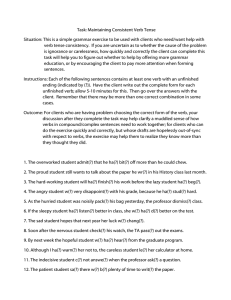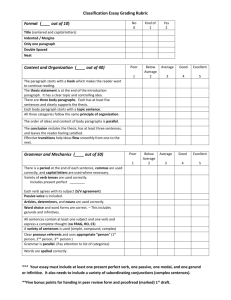TPR Lesson Planning Prepared by Shelley Thomas, Ph.D.
advertisement

TPR Lesson Planning FL6900 | India | China | USA Workshops Handout Prepared by Shelley Thomas, Ph.D. Introduction Lesson plan for any one-hour class: Plan for 50 minutes and allow for 10 minutes of classroom management or unexpected things. Also, have one extra activity in case you finish early. Bonding activities and ice-breakers should precede TPR lessons (see “preliminary bonding lesson” for ideas for adults at http://www.acceleratedacquisition.com/workshops.html). [5 min.] Review of previous day’s target vocabulary [25-30 min.] New material through actions [5-10 min.] Processing new material through varied activities [15-20 min.] [15 min.] Assessing: 5-10 sentences according to time/ pop-up grammar --Only if students are literate; otherwise, the assessment is simply whether they correctly respond with their bodies to commands and verbally with “yes/no” or choices. Try one word assessments: listing verbs on board, numbering them, and having students match verb with picture. You can encourage student competition to write verb first and hold up when you say it. Phase 1: Total Physical Response (TPR) [For information on TPR read Dr. James J. Asher’s Learning Another Language through Actions] Preparation: Google clip art and print or use to make a PowerPoint or make stick figure pictures on sheets and laminate for vocabulary to TPR. Have tape ready to stick them on the board. For examples, see Ramiro Garcia’s How to Apply TPR for Best Results and The Graphics Book 1. “TPR-able” words: Words that need no translation because they have an immediate reference—either as a classroom object or the student’s own body. These can be nouns like “book” or verbs like “stand.” Try to use students’ whole bodies and real objects. You can either give commands (i.e., use the imperative form) or narrate what “the class does” (i.e., use the third-person) depending on the way your target language works and which form is used most frequently. 2. Model / hesitate / stop: Use no more than 3 words at a time and recycle. After that, combine two commands with “and” and make sure they can do both at the same time: e.g., “touch your head and sing, jump and turn, raise your hand and walk to the wall.” Use number “one”: e.g., “one hand touches the knee, one hand touches the ear, one hand touches the floor, one hand touches the eye, etc.” This is really funny the faster you go. The hands are flying everywhere. CALA © 2015 Page 1 of 4 3. Novel commands: Words you have taught but in new, unusual combinations that you do NOT model. Example: If they know “touch the head” and “touch the table,” give them “the head touches the table” (but do not model it). The fun for them is getting it alone and, for you, watching them get it themselves. 4. Vary size of groups: Boys and girls, half the class, three people at a time, etc. 5. Chain commands: Students wait until all 3 commands or narration is given. Three things that are NOT done at the same time, e.g., “‘walk to the table, pick up the book, put it on your nose.” You will have to teach them to wait until you’ve finished the third command before they start, especially if you do not speak their language. Variation: Competition with 2 students. Once 3 commands are given, the first one finished wins. 6. Assess: Have them close their eyes while you give commands. Try to see who may need help [barometer student]. If less than 80% of the people are getting it, you may need to teach a little more slowly or fewer items. Processing Activities 1. Hold two pictures at a time, one in each hand, and call out for one to be pointed to by students—right hand or left hand. Raise the correct one after. 2. Give verbal choices holding one picture: This is sheltered, authentic communication. “Walk or sit?” It’s “sheltered” because you are keeping the quantity of target language at a minimum, and you are modeling the answer to help correct pronunciation. It’s authentic because choice questions occur all the time in real conversation. Confirm with verbal feedback of the word. 3. Call for five students to stand in front of the class—each holding one picture. As the teacher calls out the action, the person holding the corresponding picture raises and lowers the correct picture. Increase speed when you are sure they have it to help them hear target language at native speed. 4. Stick up the pictures on the board (or pull up a PowerPoint). Number them below and call out the action in the target language for the students to respond through numbers (in their own language until they learn numbers in target language). 5. Have students compete to draw quickly on mini-white boards when you shout out action and tell them to raise quickly when finished. Erasable boards are good, or have them fold 1 paper into 4 pieces and tear paper for 8 sides to draw on. 6. In pairs, one student draws a picture and shows it to his or her partner and the other says the command. 7. “Tapette” (fly-swatter activity): Divide the class into 2 teams. The class can select goofy names and/or a motto. Then call for one person from each group. Have 10 pictures taped to the board. Give the two people the fly swatters and call out the picture. The first to hit the correct picture gets the point. It can be played either with two students standing at the board or two students from far away. CALA © 2015 Page 2 of 4 8. Charades: Write a simple noun, verb, command, or narrative on slips of paper. Students choose, read it silently and act it out. Others guess it in the target language. 9. Three-Ring Circus: Put three students up front (have male/female mix), each performing a different action (but only ONE action). Be careful that it is an action that is not uncomfortable to repeat, like one person might be touching his head, the other walking to the door and the last one looking at the window. Then do circle questioning (see the bottom of this list). Use the students’ names at first then insert “he” and “she” where appropriate. 10. Pop-up grammar: Have written sentences prepared in the target language. The sentences should be constructed to prompt questions concerning subject/verb agreement, plurals, etc. First, ask students to report the meaning of the sentence. Then get them to identify the key grammar structure (e.g., indicator of subject/verb agreement, plural, etc.) in the target language. Then ask them to find another example among the other sentences. If none, create another example they haven’t seen so that they can apply it. Introduce them to grammar according to the meaning and context first. If they are children, there is no need for grammar. If they are adults in an academic class, make sure they understand the function of the word when you give the grammatical term, if they want it. The average student does not know grammatical terms. o Number the words/sentences and write them on the board or on a worksheet in the target language. Read sentences in the target language out of order. Students shout out the number corresponding to the sentence read. Call out in English out of order, they shout out the number. They translate aloud one by one after you say “who thinks they can tell me what #1 means?” etc. 11. Variation for teaching “my” and “your”: After the students touch their own body parts, chairs, tables, words, etc. The teacher teaches “my” and tells the students to “touch MY arms, or MY stomach, or MY table, etc.” and the kids rush up together to touch the teacher or the teacher’s things. It is adorable with children and great with adults who have already bonded. 12. Assessment: Write out words that have been TPR’d. First “one at a time” – like just 1 verb or 1 object—not in sentences. If they show mastery of the following routine with one word, then continue with whole sentences. See if they can tolerate little new additions like plurals, negatives, and narrative instead of commands. 13. Homework: Have students keep a picture dictionary in the form of index cards to make flash cards. Each action and noun should have a stick figure drawing they do themselves or they can find clip art. Encourage using different colors. CALA © 2015 Page 3 of 4 Circle Questioning Circling includes posing four (4) questions (from easy to hard). For beginners, use only inflection in the voice to make the question, keeping the same form used for the statement. New students might unknowingly repeat the question part of the sentence in their answers because they haven’t had enough experience to feel it is the part of the sentence that creates the question. After a few questions, ease into the proper question format. Example: (1) [+] “He is clapping?” First students answer “yes” in the target language. The teacher confirms and says, “Yes, he is clapping” in target language. (2) [-] “He is jumping?” “ Students answer “no” and teacher confirms, “No, he is not jumping, he is clapping.” (3) [_/_] “He is jumping or he is clapping?” (choice) Students answer “clapping” and teacher confirms, “Yes, he is clapping.” When giving a choice, change only ONE WORD – either the noun, verb, adverb, or subject. For beginners, use the same words you used in (1) and (2) (4) [?] “What is he doing?” (open-ended question using key interrogative words) If there is no answer there is no comprehension, so you should go back to “choice” (3) and come back to (4) Example of variation with subject: Do circling with “he” or “she” and your final question will be “who?” Example of variation with adverb: Do circling with “quickly “or “slowly” and your final question will be “how?” Circling with things like: pictures/people/ clothes/places/food- anything: At first, use only one thing for all 4 questions and then go ahead with the other things. For more advanced questioning, mix the 4 levels among many pictures. CALA © 2015 Page 4 of 4




